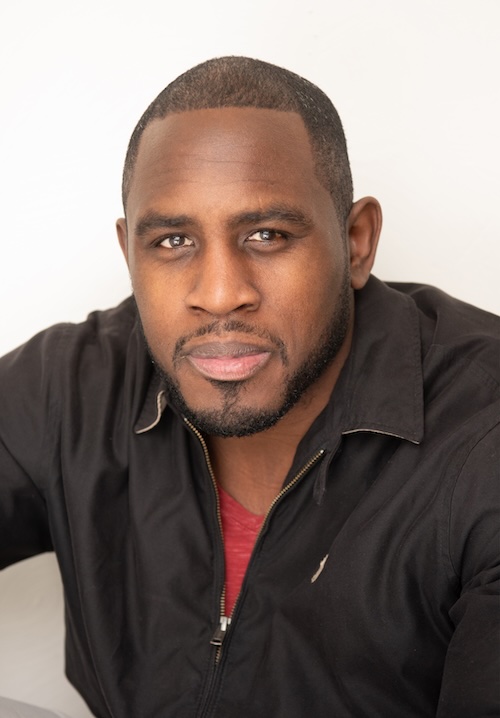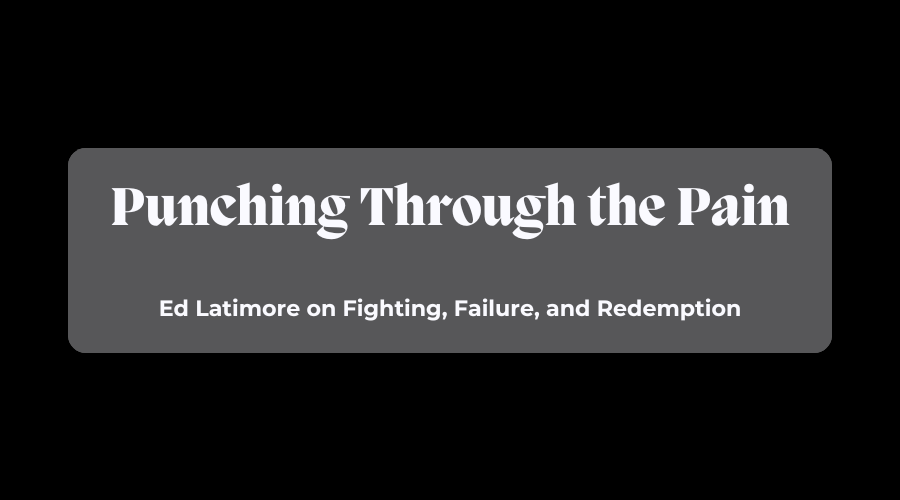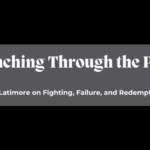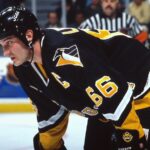
We caught up with hometown fighter, writer, and speaker Ed Latimore to talk about his powerful new book Hard Lessons From The Hurt Business: Boxing and the Art of Life, which drops today.
You might remember Ed from his days in the ring, but earlier this month, he made headlines again with a first-round TKO victory at age 40 at Highmark Stadium, nearly a decade after stepping away from the sport.
In this interview, Ed opens up about his journey growing up in Northview Heights, his struggles with sobriety, earning a physics degree, and using his story to inspire others. He’s one of the most honest and insightful new voices to come out of Pittsburgh, and his reflections hit hard.
Check out the full interview below.
1. Your book is titled “Hard Lessons From the Hurt Business: Boxing And The Art of Life.” What’s one lesson from boxing that changed your life outside the ring?
When I started boxing, I was terrible. And I started late—at 22 years old. But I kept practicing and learning. Eventually, I won the Pennsylvania State Golden Gloves, claimed a national title, and landed a major sponsorship. That experience showed me the power of deliberate practice and focus. I thought, “If I can do this with my body, why can’t I do it with anything else in my life?”
That mindset helped me earn a degree in Physics from Duquesne University at age 33, even though I had failed high school and dropped out of community college years earlier. I used the same mentality to get sober. This December marks 12 years alcohol-free.
I came to believe that anything is possible with a deliberate approach and a refusal to quit.
2. You write openly about growing up in Pittsburgh’s public housing projects. How did those early experiences shape the mindset you carried into boxing, and eventually into sobriety and academics?
Growing up in Northview Heights didn’t shape me for boxing in the way most people might expect. Sure, in a place like that, you have to fight a lot. But I was a peaceful kid. I never started fights but I never backed down from one either.
In that sense, Northview trained me to never shy away from conflict. It made me comfortable with the idea of someone trying to hurt me, which is all a boxing match really is: two people trying to hurt each other. Most people get stressed out in that situation. But I had already spent most of my childhood in environments—at home, at school, and in the neighborhood—that made pain feel normal. That turned out to be a useful trait in the ring.
But the same environment that teaches you to tolerate pain can also lead you straight into addiction.
My childhood left me with a constant sense of rejection. I often felt like a burden, like I wasn’t really wanted. Then I discovered something: alcohol is an easy excuse for people to be around you. Once I figured that out, I wanted to drink all the time so I wouldn’t have to feel rejected, and so I’d always have company. After all, you can always find a group of drinking buddies.
But those are fake relationships. You don’t actually like the people; you just like drinking. And you’d rather not do it alone.
It’s easy to get addicted to false connection, just like people get addicted to the false intimacy of porn when they don’t have a real lover.
3. You’ve described your loss in another article to Trey Lippe Morrison in 2016 as a major turning point. What did that moment teach you about failure, and how did it influence your writing in this book?
That loss was embarrassing, not just because it aired on television, but because I’d told everyone to tune in. And then I went out there and lost in the worst way possible: a first-round knockout.
I wasn’t so much worried about defeat as I was about the payday. My promoter at the time, Roc Nation Sports, cut me on the spot. The decent fight purse and monthly stipend vanished instantly. I needed income, and I needed something flexible enough to let me finish school.
I found an odd job delivering packages, until my truck malfunctioned and nearly killed me and a few unsuspecting strangers. At a crossroads, I stumbled into tutoring high school students in math and physics. It turned out to be the most rewarding work I’ve ever done.
I never would have discovered my love of teaching if I hadn’t lost that fight. The defeat put everything in perspective and reminded me of something Randy Couture once told me: “If the worst thing that happens to you is losing a fight, you’re doing all right.”
If I hadn’t taken that L, I wouldn’t have had the experiences that made me a stronger writer or helped me build a broader audience. Today, more people know me as a writer than as a boxer, although I did just step back into the ring and score a first-round TKO victory on July 12, 2025, at Highmark Stadium.
4. You graduated from Duquesne University with a degree in physics at 33—while most people that age are winding down school, you were just getting started. What role did boxing play in helping you believe that was possible?
Once I watched myself go from a terrible boxer to a high-level amateur and professional fighter, I realized I could do the same thing with my mind.
I was a terrible student in high school. Technically, I didn’t even graduate. I failed the first time by not passing the required classes, then failed again in summer school after getting caught plagiarizing an essay.
After that, I managed to flunk out of both college and community college. By the time I was 20, I had almost no confidence in myself or my ability to learn.
But I had taught myself how to box at a high level. So when I decided I needed more options in life beyond boxing, I approached education the same way I had approached the ring: with methodical, deliberate practice.
I was strategic about choosing a degree. I realized that all the highest-paying jobs required math, which meant I’d need to develop my intellectual abilities to match my physical ones. Once again, I told myself, “If I can do this with my body, then I can do it with my mind.”
Initially, I planned to study engineering because it seemed like a more straightforward career path; however, I eventually fell in love with physics. And once I did, I never looked back.
5. You recently stepped back into the ring at Highmark Stadium after an 8-year hiatus. What inspired the return—and how did it feel to fight again after all this time?
I felt great. A lot of people were worried because I’m 40 years old and hadn’t fought in almost a decade. Even my coach, Tom Yankello, tried to talk me out of it. But my mind was made up. I was confident, I felt strong—and I got the win with a first-round knockout over a tough opponent.
As for why I stepped back into the ring? That’s a multi-part answer, but I’ll keep it brief.
First, I’ve got a new book out—Hard Lessons From The Hurt Business: Boxing and the Art of Life. Since it’s a book about boxing, I figured, what better way to drum up interest than to step back into the ring? A 40-year-old author making a boxing comeback—that’s a hell of a story. And after just one fight, I’m already seeing the benefits in terms of press and attention.
Second, over the past three years, I’ve taken a deep dive into the biomechanics of boxing. Even though I had a solid amateur and pro career 8½ years ago, I struggled in certain areas because I didn’t fully understand how to move efficiently. That changed when I started coaching at Southside Boxing Gym, run by Matt Leyshock. I’m grateful for the opportunity to work in his gym. It pushed me to master the mechanics, refine what I was teaching, and internalize everything on a deeper level. That renewed understanding gave me the confidence to return.
Third, I got some lingering health issues addressed—things I didn’t even realize were holding me back. I was diagnosed with a form of hypothyroidism that was slowing my metabolism, and I also had untreated asthma. Getting those issues under control changed everything about what I was capable of physically.
And finally, I’ve never been a true heavyweight. Those guys are massive—typically 6’4” and 240 pounds. I’m 6’1” and have always fought around 215. My plan now is to drop down a weight class and see what I can accomplish in this short window of time I’ve been blessed with.
6. “Hard Lessons From the Hurt Business” is your third book, but you’ve said this one is your most personal. What was the hardest chapter to write, and why?
The first chapter of the book was, by far, the most difficult to write. Not just because it covered the earliest part of my life, but because it was the most painful.
Something people often overlook is that, generally speaking, painful memories tend to stick with us more than pleasant ones. While I hadn’t blocked out the memories of my early childhood, I hadn’t actively revisited or processed them in years. Writing forced me to go back.
Now that I’m a father myself, my dad’s absence and my mom’s abuse weigh on me more heavily than ever. There were several moments where I asked myself, “Should I even write this down?” Ultimately, there were things I left out—either due to space, tone, or appropriateness—but just thinking about them again, and deciding what to share, took a real toll on me.
I was relieved to move on from that chapter of my life, both literally and emotionally. But it’s part of my story. It helped shape who I am. So I had to write it.
7. You’ve built a large online following thanks to your writing and reflections on discipline, sobriety, and self-improvement. How does your book expand on those ideas in a deeper or more vulnerable way?
The fun part about this book is that it’s a story. A true story, but still, a story. Most of my writing is either “how-to” advice or commentary on social issues, backed by personal experience and data. But this book reads more like your favorite thriller. It follows the arc of my life—with all the highs and lows—and I didn’t fully realize how wild that arc was until I started writing it down.
Honestly, I didn’t even want to write a memoir. I didn’t think my life was that interesting. But my agent went through my past writing and interviews and told me, “You need to tell this story.”
And he was right. This is the story behind all the insights, all the reflections. It gives weight to everything I talk about because now you see where it really comes from.
8. The book isn’t just about boxing; it’s about transformation. What do you hope someone who’s never watched a fight in their life will take away from your story?
I want people to understand that at any given moment, you can choose to become something different. It starts in your mind with a vision of who you want to be. Then come the small actions that reflect that vision.
Change doesn’t happen overnight, but it does happen gradually. And before you know it, you’re living in a new world, one you first imagined, then brought to life through consistent action.
9. Your journey has been anything but linear, from struggling student to pro fighter to college graduate to author. What kept you going when things felt uncertain or overwhelming?
I’ve always believed that the difficulty of something is irrelevant if it’s essential to your success. That’s why I don’t get discouraged when things don’t go according to plan or I find myself in unexpected places. It’s all part of the journey to becoming the best—and most interesting—version of myself.
It’s not over until it’s over. And along the way, I try to enjoy the ride and make the most of this life. As long as I’m doing that, I don’t feel overwhelmed or uncertain.
To sum up this mindset, I wrote a short poem I’d like to share:
When you learn how to walk on unstable ground
An earthquake is just another day in the park
That destroys everyone else
10. With the book launching August 5, what’s next for you? Another fight, more writing, or something completely unexpected?
There’s definitely going to be another fight. Right now we’re aiming for February. In the meantime, I’ll keep writing and producing content for YouTube. I’m also launching a new podcast to explore ideas from books I enjoy, and I’ll be wrapping up my first fiction book soon.
So 2026 is shaping up to be a busy but exciting year.
If my story resonates with you, I’d love for you to check out the book. Whether you grew up on the same streets or just share that Pittsburgh grit, there’s something in it for you.
👉 Hard Lessons From The Hurt Business is out now at Amazon: https://amzn.to/4o750Cd







